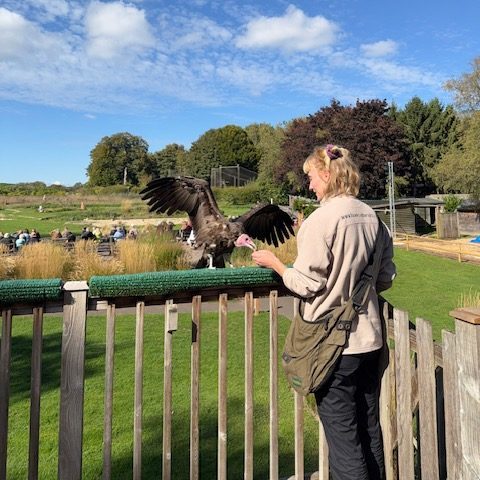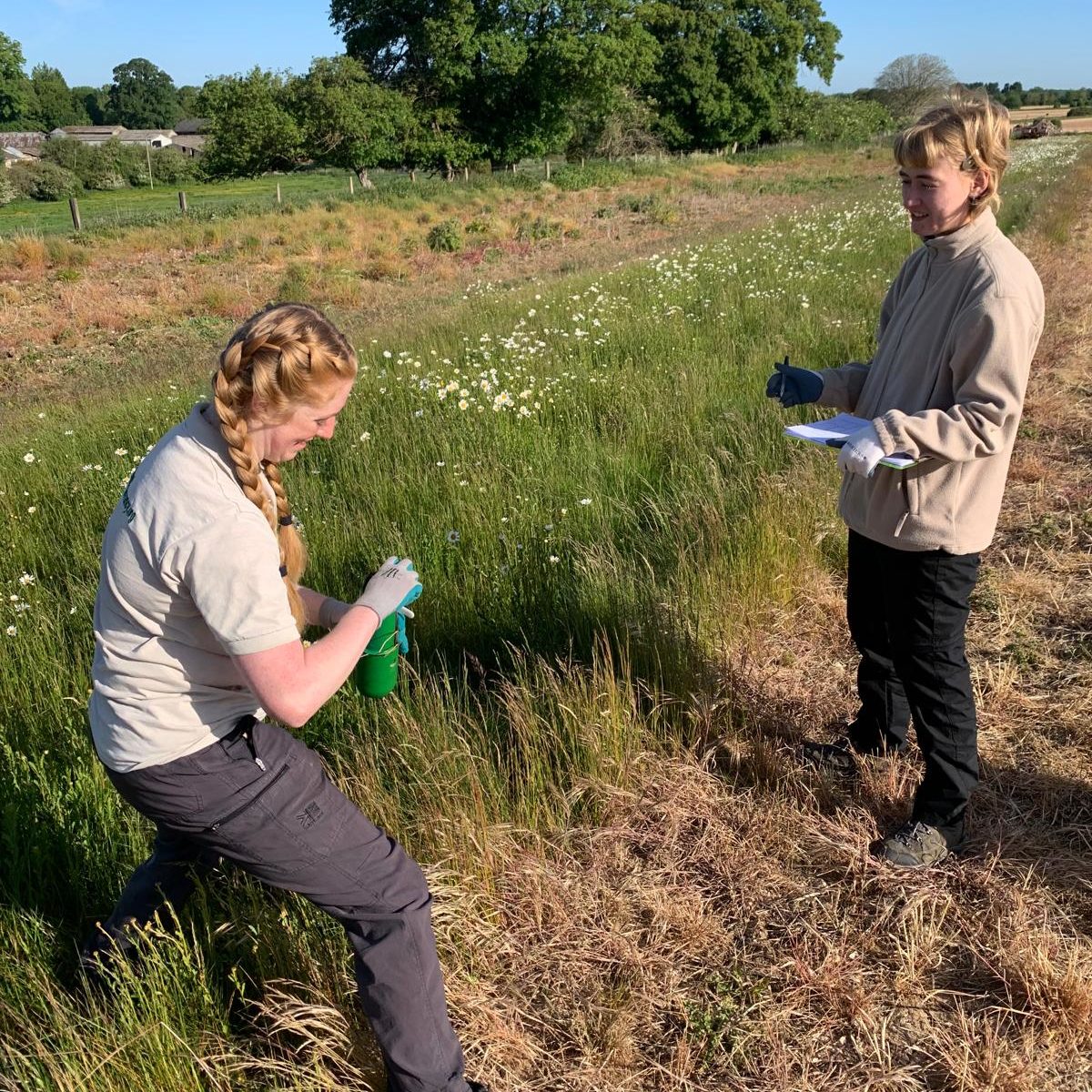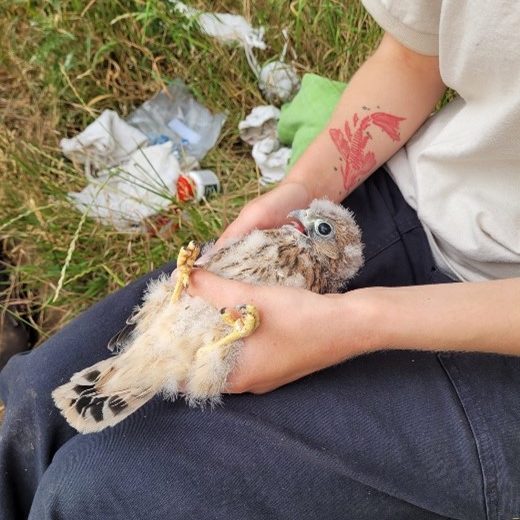
Last week, we said a fond farewell to our 2025 Conservation and Research Intern, Sorcha. Over her five month placement with us, generously funded by the Cameron Bespolka Trust, Sorcha has supported much of our work, including our onsite biodiversity, bird of prey population and small mammal population surveys. Plus, she even supported ringing Kestrel chicks as part of our Raptor Nest Box Project!
“Unfortunately, my time here at the Hawk Conservancy Trust has come to an end. These past five months have been absolutely jam-packed and I’m not sure where to begin, but I will try my best to describe some of the highlights working as the Conservation and Research Intern here at the Trust.

Since starting here in May I have been carrying out on-site biodiversity surveys, and as the weather begins to cool many of these surveys have been wrapping up. Over the summer myself and some of our lovely volunteers carried out 11 nights of moth trapping, split between Reg’s Wildflower Meadow, the Savannah Arena, the Woodland Arena and the Discovery Barn. Over 500 individuals from 290 species were recorded in total. Some of my favourites included the Leopard Moth, the Black Arches and the Chinese Character, as well as some beautiful micro moths like the Ypsolopha scabrella and the Argyresthia goedartella (the little ones don’t usually get nice, easy-to-remember names). The Trust, in particular Reg’s Wildflower Meadow, was brimming with pollinators this year, including butterflies, day flying moths, beetles, hoverflies and bees. 23 species of butterfly and six species of day-flying moth were recorded, including Small Skippers, Small Coppers and always popular, the Hummingbird Hawk-moth. It was also lovely to see the three ponds at the Trust so full of life during aquatic surveys. Some of the most exciting finds were dragonfly larva (resulting in some beautiful adult dragonflies such as Emperors, Southern Hawkers and Broad-bodied Chasers) and newt efts!


One of my favourite tasks has been conducting the early morning bird point counts, it was a real pleasure to walk around the empty Trust with only myself and the birds. The Trust hosts an incredibly diverse array of birds, my most memorable spots included Hobbies, a frequent Sparrowhawk visitor (often followed a mob of angry Swallows) and one special encounter with three Green Woodpeckers in Reg’s Meadow.
Trust Research Assistant, Tanith, very kindly taught me the ropes of small mammal trapping. Together we conducted three rounds of small mammal trapping at the Trust and four rounds at three external sites. Whilst slow to initially take off, the small mammals eventually showed themselves, giving us an insight into how they, and vicariously raptors like kestrels, were fairing this year. It was extremely interesting to see how the sites differed in terms of abundance and diversity, with one site being particularly favoured by Wood Mice (a rather energetic species to work with, to say the least). Across all sites we recorded Short-tailed Voles, Bank Voles, Common Shrews, Pygmy Shrews and Wood Mice. I am extremely grateful to Tanith, not only teaching me all she knows (about small mammals and otherwise), but putting up with me on many early mornings and late evenings whilst we put smelly casters into traps and got excited over small mammal faeces. We also had lots of exciting non-small mammal interactions, including a very close encounter with a young badger and a hunting Goshawk and lots of cool invertebrate findings (both in the traps and around the general sites).

Since the beginning of June, I have been undertaking a small project looking primarily into butterfly and day-flying moth abundance and diversity across Reg’s Wildflower Meadow and three other local wildflower meadows (Broughton Down, Magdalen Hill Down and Bury Hill Meadows). This has allowed me to work on project management skills as well as brush up on some coding skills too.
I have been lucky enough to venture out into the field with Dr Matt Stevens, the British Projects Manager, on a couple of occasions. Under the very watchful eye of Matt, a licensed ringer, I was able to ring my first ever bird, and a Kestrel chick is a pretty special first bird. We also went out to investigate a couple of Barn Owl nest boxes in the area and made a very exciting discovery of a male and female Barn Owl, both seven years old and doing very well. Matt is an absolute wealth of knowledge on these amazing birds (on many birds), I am extremely grateful to have been able to pick his brains and learn so much from him on only a few trips out.
Towards the end of my internship, I have also managed to squeeze in a few raptor transects to monitor raptor densities across the south-east of the UK. This has taken me around the local area and as far as Dungeness, Kent, they are an extremely lovely way to spend a day. I have been lucky enough to see Kestrels, Ravens, Red Kites, Common Buzzards, Goshawks, Sparrowhawks and Marsh Harriers!
I have spent some time during this internship getting to grips with camera traps that will hopefully lay the foundations for some exciting new conservation and research work the Trust will be undertaking in the future. This has involved putting camera traps on roadkill to attempt to monitor raptor’s, particularly scavengers like Red Kites and Common Buzzards, interactions with roadkill and traffic. Roadkill so far has mostly been taken by foxes, and one strong cat, but a capture of a Red Kite scooping up a Common Wood Pigeon from the road was enough to fuel a lot of excitement for the whole day.


I am incredibly grateful for this opportunity, and I have learnt so much from so many people during my time as Conservation and Research Intern at the Trust. I have really enjoyed my time working here, everyone has made it an incredibly welcoming environment, and I couldn’t ask for better people to work with. My biggest thank you goes to Dr Jamie McKaughan, the Conservation and Research Coordinator, who has supported me immensely throughout this internship.
A huge thank you to the Cameron Bespolka Trust. This internship has been a huge stepping stone into a career in conservation and without their support I would not have been here.”